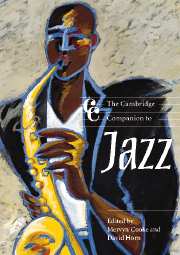Book contents
15 - Analysing jazz
from Part Four - Jazz soundings
Published online by Cambridge University Press: 28 September 2011
Summary
In reply to the . . . question, ‘What is jazz, Mr Waller?’ the late and great Fats is supposed to have sighed: ‘Madam, if you don’t know by now, DON’T MESS WITH IT!’
[stearns 1956, 11]Though Waller (if he actually made that remark) was speaking to a neophyte jazz fan, had he lived to see scholars ‘messing’ with jazz he probably would have disapproved of that activity as well. They spend lengthy amounts of time listening to it, reading and thinking about it, for they find the music fascinating, irresistible and sometimes mysterious. Ever curious, they examine it, using a variety of skills and approaches. Then they write about it in their spare time (no one makes a living analysing music), hoping to reach an interested audience with their insights into the music. Readership and book sales are minuscule by popular-press standards. But if the readership is small, jazz analysts still may take pride in providing informed alternatives to the pseudo-intellectual verbiage and scrambled terminology that sometimes characterises jazz writing for the general reader.
Music analysts strive to describe or explain musical phenomena with some combination of words, musical notation and graphic representation. But while a jazz piece, like any other piece of music, may be a fixed object – an audio recording or written score – analyses may be dramatically different, as John Brownell has pointed out (1994, 23), depending upon what each analyst listens for and finds in a piece.
- Type
- Chapter
- Information
- The Cambridge Companion to Jazz , pp. 286 - 298Publisher: Cambridge University PressPrint publication year: 2003
- 2
- Cited by

